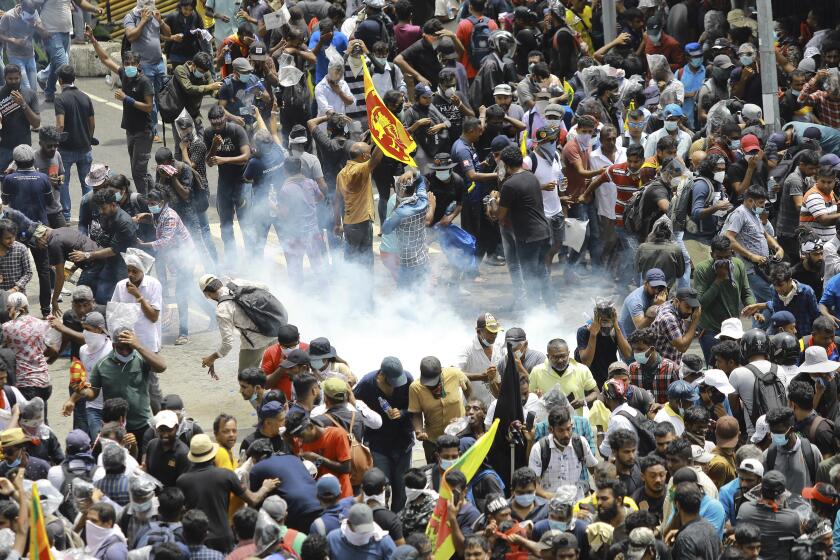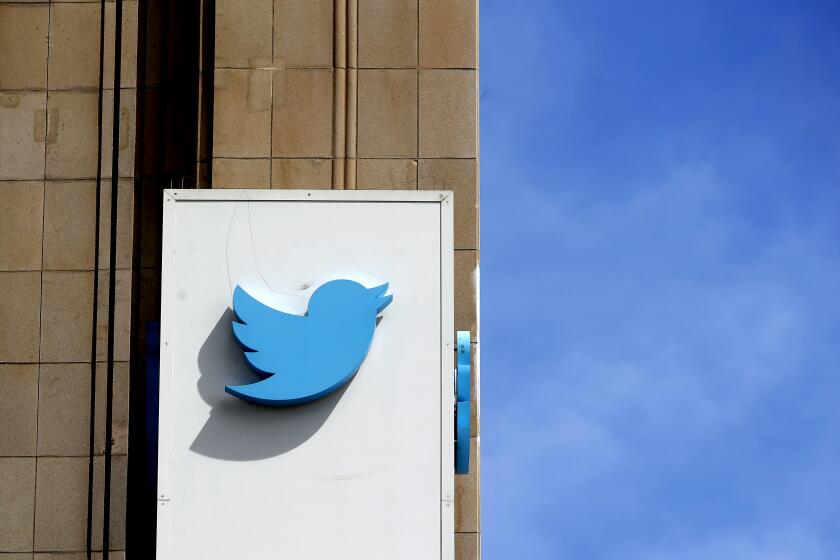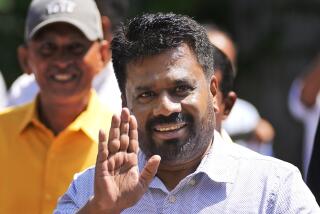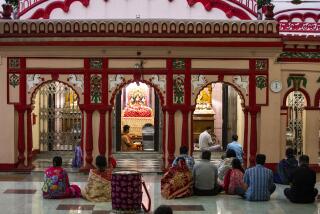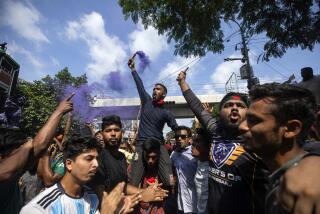Op-Ed: Our long, bloody road to Sri Lanka’s fragile harmony
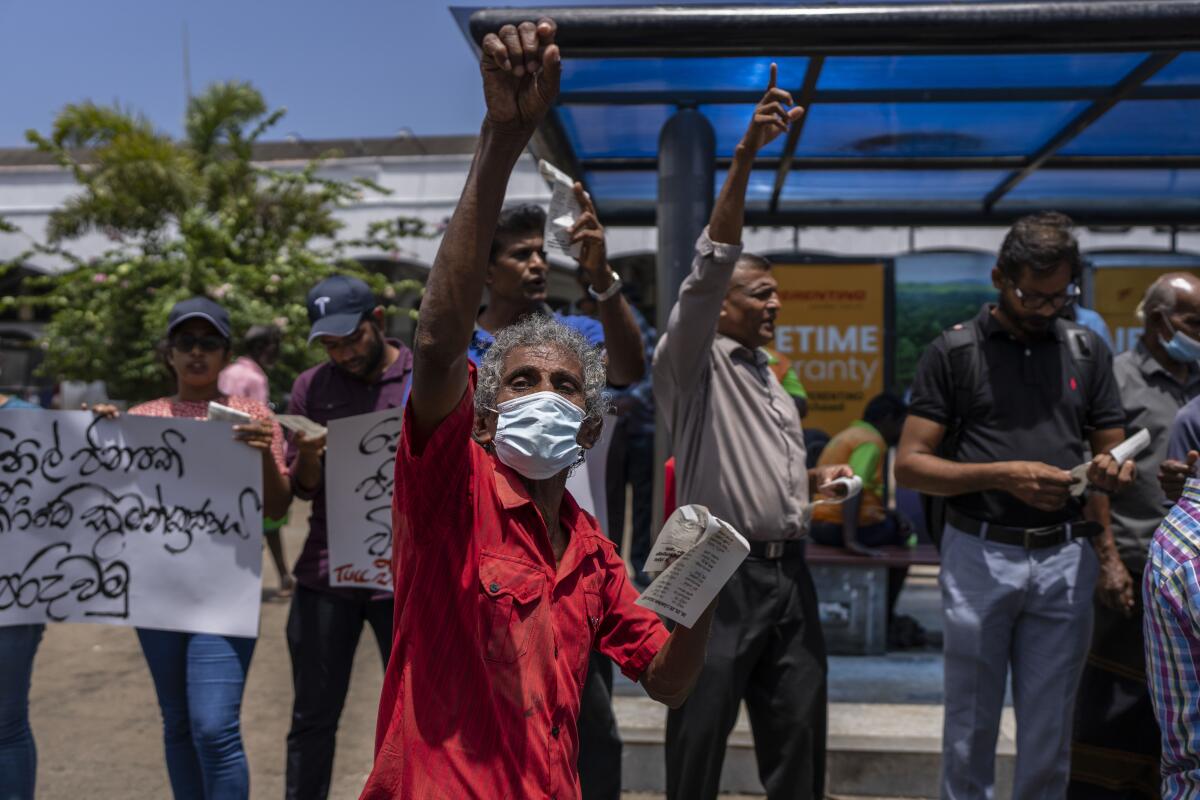
COLOMBO, Sri Lanka — After months of turmoil and severe government repression in Sri Lanka, July 9 was meant to be a big push from protesters. Despite dire fuel shortages and few transport options, people stockpiled gasoline, shared trucks and filled trains to join the day of protest. Many of us from Colombo, the capital, walked across town, rivers of humanity merging. The atmosphere was electric.
My friends and I were near the presidential secretariat — a colonial-era building that served as President Gotabaya Rajapaksa’s office. But the crowd was so dense that we couldn’t see what was happening: Families with small children, students, artists, blue- and white-collar workers, trade unionists, academics, professionals. Street carts did brisk business on the margins selling ice cream and cups of noodles.
Despite spotty internet service, we caught glimpses of what was unfolding in surreal videos. Demonstrators had made it not only inside Rajapaksa’s office, but to his residence, diving into the president’s pool. Rajapaksa eventually fled last week to Singapore. Ranil Wickremesinghe, who is Rajapaksa’s strongest ally, became acting president and declared a state of emergency on Monday. Protesters are calling for Wickremesinghe’s resignation, though he’s seen as the frontrunner as lawmakers are set to vote Wednesday on a new president to complete Rajapaksa’s term.
Sri Lanka’s president fled the country this week for Singapore. Protesters are demanding an end to an entrenched political order — but not the country’s democratic institutions.
From our July 9 protest, there’s one video clip that I keep rewatching, perhaps taken from a tall building or from a drone. It shows people surging up the steps of the secretariat. The scene fills me with joy — and with grief, that it took so long and cost so much for us to get here.
Since April, the protests have represented a cross-section of the entire Sri Lankan polity, a rare and fragile harmony, a belated mass opposition to the Rajapaksa family and the crisis they’ve nurtured for two decades. Sri Lanka has never seen this degree of civil disobedience and protest before. People argue about where this all began. They point to different flashpoints in our history: This year’s collapsing economy; Gotabaya Rajapaksa’s election in 2019; the beginning of the civil war between the Sinhala Buddhist majority and Tamil minority in 1983; the anti-Tamil language discrimination of the 1950s and ’60s; the denial of citizenship to Tamil people in the Ceylon Citizenship Act of 1948. The struggle has many roots, and with every fresh turn of crisis, people suffer and die for it.
It’s painful to witness today’s protests and remember that there wasn’t a similar uprising against the Rajapaksas’ role during the civil war’s bloody end in 2009. The 26-year war of the Sinhala-dominated Sri Lankan state against the Liberation Tigers of Tamil Eelam was, in those final years, directed by Gotabaya Rajapaksa, then-defense secretary, and his brother, who was president at the time. The government is accused of being responsible in the deaths of tens of thousands of civilians in the last months of the war. The United Nations estimated 70,000 civilians were unaccounted for during the war’s final phase. Tamil activists call it genocide and say the true death toll is more than twice as high. No one has been held accountable.
Until 2020, most of the Sinhala polity supported the Rajapaksas, reflecting a deep-seated Sinhala-Buddhist supremacism. Since Sri Lanka’s independence from the British in 1948, the engine of Sinhala politics has been to profit from racial and religious divides: Sinhala against Tamil, Buddhist against Muslim, driving decades of discrimination and violence. The Rajapaksas refined that machine to its peak of cruelty in the final years of the war.
The outcome of a Twitter lawsuit will likely reverberate far beyond India, which is a bellwether in the ongoing battle over global internet freedom.
The result? Brutal militarization; decision-making as disconnected from reality as the racism that drives it; ruinous debt from the Rajapaksas borrowing massively from international capital markets to fund their war; and the ongoing military occupation of the north of the island. The Rajapaksas’ inability to keep the lights on and maintain affordable food prices for millions of people finally created mass Sinhala resistance.
Since April, protesters have built tents and temporary structures to occupy the area outside the secretariat: stations for medics and legal aid; forums for political discussion; a makeshift library and protest art exhibit. This is not mere unrest but a decentralized popular movement after months of hunger and economic devastation, sending a clear message to a despotic, failed government to step down.
For many of us, our joy at Rajapaksa’s resignation is tempered with wariness. The videos that surfaced of July 9 were not only of citizens jubilantly occupying the palace of the oligarchs, but also of the army shooting at protesters on the street outside. Negotiations with the International Monetary Fund for a bailout and support from other countries are still underway. Gotabaya Rajapaksa is gone, at least for now, but the poisonous legacy of his family is still with us: the crisis they built, the debts they left for the people to pay and the long vigil for justice, for an answer to everything that happened on their watch.
Vajra Chandrasekera is from Colombo, Sri Lanka. His debut novel, “The Saint of Bright Doors,” is forthcoming in 2023. @_vajra
More to Read
A cure for the common opinion
Get thought-provoking perspectives with our weekly newsletter.
You may occasionally receive promotional content from the Los Angeles Times.
